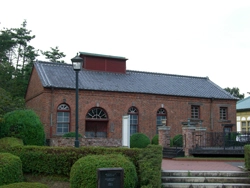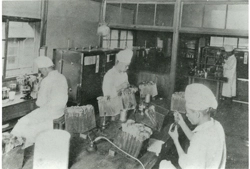Today, Daiichi Sankyo Co., Ltd. (Daiichi Sankyo) has offices, plants, and research laboratories located throughout Japan. One of these, the Shinagawa R&D Center, which can be seen on the right side of the Tokaido bullet train bound for Tokyo just before arriving at Shinagawa Station, stands on the site of the former Shinagawa plant, which was the main manufacturing plant of one of Daiichi Sankyo’s predecessor companies: Sankyo Co., Ltd. (Sankyo). This story is about the history of the Shinagawa plant, a portion of which has been relocated and is now on display at the historical “Meiji Mura” open-air museum in Aichi Prefecture.
Establishment of a plant ten times larger than ever before

The former Shinagawa plant, relocated to the
“Meiji Mura” museum in Aichi Prefecture, Japan.
It is the original red-brick building from the time
Matasaku Shiobara purchased it.
Sankyo Shoten, the predecessor of Sankyo, was founded in 1899. The company began its business with the sale of Taka-Diastase, a gastrointestinal drug developed by Dr. Jokichi Takamine in the U.S., followed by the launch of Adrenalin, which was also crystallized by Dr. Takamine. Around the same time, Sankyo also became the sole Japanese distributor for the U.S. pharmaceutical company Parke-Davis (now Pfizer), finally entering into the prescription (innovative) pharmaceutical business.
In 1905, Sankyo established its first plant in Hakozaki, close to the current headquarters in Tokyo, where it manufactured a succession of medicines, including the nutritional supplement Glyconal and the lactobacillus preparation Lactostase; however, the plant soon outgrew its capacity. Sankyo Shoten’s founder, Matasaku Shiobara, wanted to further expand its production capacity, and upon hearing that a former government-owned glass factory in Shinagawa was vacant, he went to inspect it. However, the site was much larger than he had expected, consisting of three one-story red brick buildings about 10 times the size of the Hakozaki plant.
Even the enterprising Shiobara was initially hesitant, but in 1908 he purchased the plant, declaring that it was not worth entering the pharmaceutical business unless the company could make use of a plant this size. Thus, the Sankyo Shoten Shinagawa plant was established.

The Shinagawa plant in operation at the time.
The couple decided to live on-site, solving one problem at a time to get the business off the ground
The Shinagawa plant became fully operational in the fall of the following year, 1909, but things did not go smoothly at first. Despite transferring much of the equipment and production items from the Hakozaki plant, vast areas remained deserted. Shiobara found this situation unacceptable, and within 2 to 3 months of the plant’s opening, he renovated one of the factory buildings and moved in to live there. From then on, he spent his days making rounds of the plant, giving instructions, visiting the store in Nihonbashi Muromachi to supervise sales, and then returning to the plant. His wife, Chiyo, also helped run the plant by preparing meals for the dozens of employees.
Subsequently, the company engaged Dr. Junichiro Shimoyama, who was known at the time as the foremost pharmaceutical scientist in Japan, as an academic advisor. Three years after the establishment of the plant, the company succeeded in commercializing Dr. Umetaro Suzuki’s Oryzanin solution (click here to read the story of Dr. Umetaro Suzuki). By this time, the plant was fully equipped with a chemical testing room, a tableting room and other formulation rooms, and a drying room. It was now ready to produce pharmaceutical products, such as the dermatological drug Thionol and also Glyconal. With the plant’s future looking promising, Mr. Shiobara and his wife moved to a new house in Iikura Katamachi (present-day Roppongi, Minato-ku, Tokyo). In the ensuing years, the Shinagawa plant continued to grow and became Sankyo’s main plant.
Was it fate that led to the establishment of the Shinagawa plant?
It was later discovered that the Shinagawa plant had a curious connection with Mr. Shiobara. When the plant was still a glassworks, the director was Keisuke Otori, the grandfather of Shiobara’s wife, Chiyo. Additionally, the brick chimneys of the factory were built by Jokichi Takamine and others, who were students at the Imperial College of Engineering (Kobu-Dai-Gakko), where Otori was once the president, as voluntary labor. Hence, it is almost as if fate brought the factory and the Shiobaras together.
The Shinagawa plant was protected and nurtured by Matasaku Shiobara and his wife, Chiyo, to ensure stable production and delivery of a wide range of pharmaceuticals to the public. To this day, the plant continues to operate in spirit as Daiichi Sankyo’s Shinagawa R&D Center, where researchers are engaged in the research and development of innovative medicines to meet diverse medical needs of patients around the world.